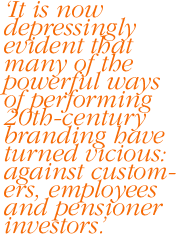

 |
 |
Chapter summary
Brand, Dynamic Valuation, and Transparent Governance of Living Systems
The dynamic valuation task of the living system analyst is to map whether organisations are spinning virtuous life spirals or vicious death spirals. Sounds spooky, but it is actually one of our human rights to know, identify and openly share and care about true relationships. Transparency mapping brings to the surface the kinds of assumptions that lesser number crunchers have sought to conceal over the years that globalisation has evolved. When we think of firms like Andersen, the metaphor that comes to mind is one of a new world of human value exchanges put in the monopoly hands of cartographers who almost deliberately sketch lands in wrong areas. What immense control you can have of the business globe when you cause most people to sail off in the wrong direction—away from either a new economy or an improved society.
Brands were one of the most common intangible vehicles navigated into murky waters so that a few vested interests could perpetuate their process models. It is now depressingly evident that many of the powerful ways of performing 20th-century branding, have turned vicious: against customers, employees and pensioner investors. The global forms of these costly brands are also a major cause of conflicts between local cultures around the world.
However, the newly discovered mathematics of transparency mapping (Macrae, Mitchell, Gordon. 2003: The Map, John Wiley—transparency communities) makes win–win governance practical. Managers, economists, policy makers (Transparency’s Maps of Missing Governance reviewed in European Union’s virtual library on intangibles) and opinion leaders of organisational systems can now design and steward brands which respect living system dynamics. Win–win is a natural human construct which means that when you make different promises to two or more groups of people, you are doing so knowing how to keep all of those promises because they are mutually reinforcing. Today we can—and must—conceive promotions and deploy media that go well beyond mere image-making lifestyles. Total Brand Corporate Responsibility models (Macrae, Yan, Kitchin, guest editors of 2003 Special Double Issue of Journal of Brand Management—Total Branding of Corporate Responsibility [TBCR]) purposefully focus on reality-making to promote win–win relationship exchanges between people in ways that connect human inspiration and network greater value. For me, our challenges today have chilling urgency -read my father’s lips written from his editorial desk at The Economist: ‘by 2005 the gap in incomes and expectations between rich and poor nations was recognised as man’s most dangerous problem.’
Beyond is our invitation to boldly go where no enterprise has been before. To this date, all of us in business have systemically failed to unite the disciplines which believe humanity has a stake in working with great organisations and seeing through their purposes. We invite like-minded people to openly benchmark and innovate humanly focusing brands. Before we move forward together, let us learn from the crisis of trust we have reached today. We are sailing dangerously close to a perfect storm—carelessly losing all human proportion of innovation forces such as globalisation and networking. We must turn round from this most unpromising beginning to a new millennium. To do this, know why economic democracy(Kelly. 2002), is at stake. We will need the courage to help everyone see how risks and terror were compounded by incompetent mathematics, peddled by androids, and highly geared to reward leaders with Enronitis rushing through their veins.
Read more in the full book
Next chapter: Leadership branding
